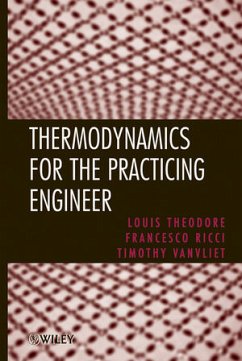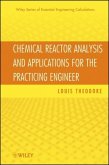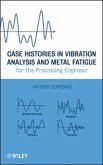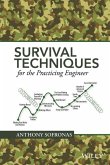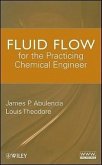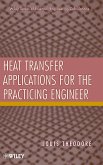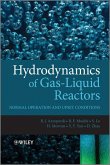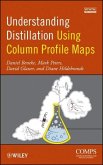- Gebundenes Buch
- Merkliste
- Auf die Merkliste
- Bewerten Bewerten
- Teilen
- Produkt teilen
- Produkterinnerung
- Produkterinnerung
This book concentrates specifically on the applications of thermodynamics, rather than the theory. It addresses both technical and pragmatic problems in the field, and covers such topics as enthalpy effects, equilibrium thermodynamics, non-ideal thermodynamics and energy conversion applications. Providing the reader with a working knowledge of the principles of thermodynamics, as well as experience in their application, it stands alone as an easy-to-follow self-teaching aid to practical applications and contains worked examples.
Andere Kunden interessierten sich auch für
![Chemical Reactor Analysis and Applications for the Practicing Engineer Chemical Reactor Analysis and Applications for the Practicing Engineer]() Louis TheodoreChemical Reactor Analysis and Applications for the Practicing Engineer160,99 €
Louis TheodoreChemical Reactor Analysis and Applications for the Practicing Engineer160,99 €![Case Histories in Vibration Analysis and Metal Fatigue for the Practicing Engineer Case Histories in Vibration Analysis and Metal Fatigue for the Practicing Engineer]() Anthony SofronasCase Histories in Vibration Analysis and Metal Fatigue for the Practicing Engineer104,99 €
Anthony SofronasCase Histories in Vibration Analysis and Metal Fatigue for the Practicing Engineer104,99 €![Survival Techniques for the Practicing Engineer Survival Techniques for the Practicing Engineer]() Anthony SofronasSurvival Techniques for the Practicing Engineer59,99 €
Anthony SofronasSurvival Techniques for the Practicing Engineer59,99 €![Fluid Flow for the Practicing Chemical Engineer Fluid Flow for the Practicing Chemical Engineer]() James Patrick AbulenciaFluid Flow for the Practicing Chemical Engineer163,99 €
James Patrick AbulenciaFluid Flow for the Practicing Chemical Engineer163,99 €![Heat Transfer Heat Transfer]() Louis TheodoreHeat Transfer157,99 €
Louis TheodoreHeat Transfer157,99 €![Hydrodynamics of Gas-Liquid Reactors Hydrodynamics of Gas-Liquid Reactors]() Barry AzzopardiHydrodynamics of Gas-Liquid Reactors195,99 €
Barry AzzopardiHydrodynamics of Gas-Liquid Reactors195,99 €![Understanding Distillation Using Column Profile Maps Understanding Distillation Using Column Profile Maps]() Daniel BenekeUnderstanding Distillation Using Column Profile Maps193,99 €
Daniel BenekeUnderstanding Distillation Using Column Profile Maps193,99 €-
-
-
This book concentrates specifically on the applications of thermodynamics, rather than the theory. It addresses both technical and pragmatic problems in the field, and covers such topics as enthalpy effects, equilibrium thermodynamics, non-ideal thermodynamics and energy conversion applications. Providing the reader with a working knowledge of the principles of thermodynamics, as well as experience in their application, it stands alone as an easy-to-follow self-teaching aid to practical applications and contains worked examples.
Hinweis: Dieser Artikel kann nur an eine deutsche Lieferadresse ausgeliefert werden.
Hinweis: Dieser Artikel kann nur an eine deutsche Lieferadresse ausgeliefert werden.
Produktdetails
- Produktdetails
- Verlag: John Wiley & Sons / Wiley
- 1. Auflage
- Seitenzahl: 432
- Erscheinungstermin: 1. Mai 2009
- Englisch
- Abmessung: 236mm x 155mm x 25mm
- Gewicht: 717g
- ISBN-13: 9780470444689
- ISBN-10: 0470444681
- Artikelnr.: 26010192
- Herstellerkennzeichnung
- Libri GmbH
- Europaallee 1
- 36244 Bad Hersfeld
- gpsr@libri.de
- Verlag: John Wiley & Sons / Wiley
- 1. Auflage
- Seitenzahl: 432
- Erscheinungstermin: 1. Mai 2009
- Englisch
- Abmessung: 236mm x 155mm x 25mm
- Gewicht: 717g
- ISBN-13: 9780470444689
- ISBN-10: 0470444681
- Artikelnr.: 26010192
- Herstellerkennzeichnung
- Libri GmbH
- Europaallee 1
- 36244 Bad Hersfeld
- gpsr@libri.de
LOUIS THEODORE, ENG SCD, is a consultant for Theodore Tutorials, a company specializing in providing training solutions to industry, academia, and government. In addition to receiving awards from the International Air & Waste Management Association and the American Society for Engineering Education, Dr. Theodore is the author/coauthor of eighty-one books, including Nanotechnology: Basic Calculations for Engineers and Scientists (Wiley) and Handbook of Chemical and Environmental Engineering Calculations (Wiley), plus nearly 100 technical publications. He was recently (2008) recognized at Madison Square Garden for his contributions to basketball and the youth of America. FRANCESCO RICCI is currently a junior chemical engineering student at Manhattan College. A member of both Tau Beta Pi and Omega Chi Epsilon, and the recipient of numerous academic awards and scholarships, Mr. Ricci is the author of the solutions manual to this text, and a contributing author to the 2009 title Introduction to Environmental Management. TIMOTHY VANVLIET is currently a senior chemical engineering student at Manhattan College. Mr. VanVliet is a member of Omega Chi Epsilon, and has received numerous academic awards and scholarships.
PREFACE. Part I INTRODUCTION. 1. Basic Calculations. Introduction. Units and Dimensions. Conversion of Units. The Gravitational Constant, gc. Significant Figures and Scientific Notation. References. 2. Process Variables. Introduction. Temperature. Pressure. Moles and Molecular Weights. Mass and Volume. Viscosity. Heat Capacity. Thermal Conductivity. Reynolds Number. pH. Vapor Pressure. Property Estimation. References. 3. Gas Laws. Introduction. Boyle's and Charles' Laws. The Ideal Gas Law. Standard Conditions. Partial Pressure and Partial Volume. Critical and Reduced Properties. Non-Ideal Gas Behavior. Non-Ideal Mixtures. References. 4. Conservation Laws. Introduction. The Conservation Laws. The Conservation Law for Momentum. The Conservation Law for Mass. The Conservation Law for Energy. References. 5. Stoichiometry. Introduction. Combustion of Methane. Excess and Limiting Reactant(s). Combustion of Ethane. Combustion of Chlorobenzene. References. 6. The Second Law of Thermodynamics. Introduction. Qualitative Review of the Second Law. Quantitative Review of the Second Law. Ideal Work and Lost Work. The Heat Exchanger Dilemma. Chemical Plant and Process Applications. The Third Law of Thermodynamics. References. Part II ENTHALPY EFFECTS. 7. Sensible Enthalpy Effects. Introduction. The Gibbs Phase Rule (GPR). Enthalpy Values. Heat Capacity Values. Predictive Methods for Heat Capacity. References. 8. Latent Enthalpy Effects. Introduction. The Clausius-Clapeyron (C-C) Equation. Predictive Methods: Normal Boiling Point. Predictive Methods: Other Temperatures. Industrial Applications. References. 9. Enthalpy of Mixing Effects. Introduction. Enthalpy-Concentration Diagrams. H2SO4-H2O Diagram. NaOH-H2O Diagram. Enthalpy of Mixing at Infinite Dilution. Evaporator Design. References. 10. Chemical Reaction Enthalpy Effects. Introduction. Standard Enthalpy of Formation. Standard Enthalpy of Reaction. Effect of Temperature on Enthalpy of Reaction. Gross and Net Heating Values. References. Part III EQUILIBRIUM THERMODYNAMICS. 11. Phase Equilibrium Principles. Introduction. Psychometric Chart. Raoult's Law. Henry's Law. Raoult's Law vs Henry's Law. Vapor-Solid Equilibrium. Liquid-Solid Equilibrium. References. 12. Vapor-Liquid Equilibrium Calculations. Introduction. The DePriester Charts. Raoult's Law Diagrams. Vapor-Liquid Equilibrium in Nonideal Solutions. NRTL Diagrams. Wilson Diagrams. Relative Volatility. References. 13. Chemical Reaction Equilibrium Principles. Introduction. Standard Free Energy of Formation,
Gof. Standard Free Energy of Reaction,
Go. The Chemical Reaction Equilibrium Constant, K. Effect of Temperature on
Go and K: Simplified Approach. Effect of Temperature on
Go and K:
, ß, and
Data. Effect of Temperature on
Go and K: a, b, and c Data. Procedures to Determine K. References. 14. Chemical Reaction Equilibrium Applications. Introduction. Rate vs Equilibrium Considerations. Extent of Reaction. The Reaction Coordinate. Gas Phase Reactions. Equilibrium Conversion Calculations: Simplified Approach. Equilibrium Conversion Calculations: Rigorous Approach. Other Reactions. References. Part IV OTHER TOPICS. 15. Economic Considerations. Introduction. Capital Costs. Operating Costs. Project Evaluation. Perturbation Studies in Optimization. References. 16. Open-Ended Problems. Introduction. Developing Students' Power of Critical Thinking. Creativity. Brainstorming. Inquiring Minds. References. 17. Other ABET Topics. Introduction. Environmental Management. Health, Safety, and Accident Management. Numerical Methods. Ethics. References. 18. Fuel Options. Introduction. Fuel Properties. Natural Gas. Liquid Fuels. Coal. Fuel Selection. Stoichiometric Calculations. References. 19. Exergy: The Concept of "Quality Energy". Introduction. The Quality of Heat vs Work. Exergy. Quantitative Exergy Analysis. Environmental Impact. Exergy Efficiency. References. Appendix. I. Steam Tables. A. Saturated Steam. B. Superheated Steam. C. Saturated Steam-Ice. II. SI Units. III. Conversion Constants. IV. Selected Common Abbreviations. References. Index.
Gof. Standard Free Energy of Reaction,
Go. The Chemical Reaction Equilibrium Constant, K. Effect of Temperature on
Go and K: Simplified Approach. Effect of Temperature on
Go and K:
, ß, and
Data. Effect of Temperature on
Go and K: a, b, and c Data. Procedures to Determine K. References. 14. Chemical Reaction Equilibrium Applications. Introduction. Rate vs Equilibrium Considerations. Extent of Reaction. The Reaction Coordinate. Gas Phase Reactions. Equilibrium Conversion Calculations: Simplified Approach. Equilibrium Conversion Calculations: Rigorous Approach. Other Reactions. References. Part IV OTHER TOPICS. 15. Economic Considerations. Introduction. Capital Costs. Operating Costs. Project Evaluation. Perturbation Studies in Optimization. References. 16. Open-Ended Problems. Introduction. Developing Students' Power of Critical Thinking. Creativity. Brainstorming. Inquiring Minds. References. 17. Other ABET Topics. Introduction. Environmental Management. Health, Safety, and Accident Management. Numerical Methods. Ethics. References. 18. Fuel Options. Introduction. Fuel Properties. Natural Gas. Liquid Fuels. Coal. Fuel Selection. Stoichiometric Calculations. References. 19. Exergy: The Concept of "Quality Energy". Introduction. The Quality of Heat vs Work. Exergy. Quantitative Exergy Analysis. Environmental Impact. Exergy Efficiency. References. Appendix. I. Steam Tables. A. Saturated Steam. B. Superheated Steam. C. Saturated Steam-Ice. II. SI Units. III. Conversion Constants. IV. Selected Common Abbreviations. References. Index.
PREFACE. Part I INTRODUCTION. 1. Basic Calculations. Introduction. Units and Dimensions. Conversion of Units. The Gravitational Constant, gc. Significant Figures and Scientific Notation. References. 2. Process Variables. Introduction. Temperature. Pressure. Moles and Molecular Weights. Mass and Volume. Viscosity. Heat Capacity. Thermal Conductivity. Reynolds Number. pH. Vapor Pressure. Property Estimation. References. 3. Gas Laws. Introduction. Boyle's and Charles' Laws. The Ideal Gas Law. Standard Conditions. Partial Pressure and Partial Volume. Critical and Reduced Properties. Non-Ideal Gas Behavior. Non-Ideal Mixtures. References. 4. Conservation Laws. Introduction. The Conservation Laws. The Conservation Law for Momentum. The Conservation Law for Mass. The Conservation Law for Energy. References. 5. Stoichiometry. Introduction. Combustion of Methane. Excess and Limiting Reactant(s). Combustion of Ethane. Combustion of Chlorobenzene. References. 6. The Second Law of Thermodynamics. Introduction. Qualitative Review of the Second Law. Quantitative Review of the Second Law. Ideal Work and Lost Work. The Heat Exchanger Dilemma. Chemical Plant and Process Applications. The Third Law of Thermodynamics. References. Part II ENTHALPY EFFECTS. 7. Sensible Enthalpy Effects. Introduction. The Gibbs Phase Rule (GPR). Enthalpy Values. Heat Capacity Values. Predictive Methods for Heat Capacity. References. 8. Latent Enthalpy Effects. Introduction. The Clausius-Clapeyron (C-C) Equation. Predictive Methods: Normal Boiling Point. Predictive Methods: Other Temperatures. Industrial Applications. References. 9. Enthalpy of Mixing Effects. Introduction. Enthalpy-Concentration Diagrams. H2SO4-H2O Diagram. NaOH-H2O Diagram. Enthalpy of Mixing at Infinite Dilution. Evaporator Design. References. 10. Chemical Reaction Enthalpy Effects. Introduction. Standard Enthalpy of Formation. Standard Enthalpy of Reaction. Effect of Temperature on Enthalpy of Reaction. Gross and Net Heating Values. References. Part III EQUILIBRIUM THERMODYNAMICS. 11. Phase Equilibrium Principles. Introduction. Psychometric Chart. Raoult's Law. Henry's Law. Raoult's Law vs Henry's Law. Vapor-Solid Equilibrium. Liquid-Solid Equilibrium. References. 12. Vapor-Liquid Equilibrium Calculations. Introduction. The DePriester Charts. Raoult's Law Diagrams. Vapor-Liquid Equilibrium in Nonideal Solutions. NRTL Diagrams. Wilson Diagrams. Relative Volatility. References. 13. Chemical Reaction Equilibrium Principles. Introduction. Standard Free Energy of Formation,
Gof. Standard Free Energy of Reaction,
Go. The Chemical Reaction Equilibrium Constant, K. Effect of Temperature on
Go and K: Simplified Approach. Effect of Temperature on
Go and K:
, ß, and
Data. Effect of Temperature on
Go and K: a, b, and c Data. Procedures to Determine K. References. 14. Chemical Reaction Equilibrium Applications. Introduction. Rate vs Equilibrium Considerations. Extent of Reaction. The Reaction Coordinate. Gas Phase Reactions. Equilibrium Conversion Calculations: Simplified Approach. Equilibrium Conversion Calculations: Rigorous Approach. Other Reactions. References. Part IV OTHER TOPICS. 15. Economic Considerations. Introduction. Capital Costs. Operating Costs. Project Evaluation. Perturbation Studies in Optimization. References. 16. Open-Ended Problems. Introduction. Developing Students' Power of Critical Thinking. Creativity. Brainstorming. Inquiring Minds. References. 17. Other ABET Topics. Introduction. Environmental Management. Health, Safety, and Accident Management. Numerical Methods. Ethics. References. 18. Fuel Options. Introduction. Fuel Properties. Natural Gas. Liquid Fuels. Coal. Fuel Selection. Stoichiometric Calculations. References. 19. Exergy: The Concept of "Quality Energy". Introduction. The Quality of Heat vs Work. Exergy. Quantitative Exergy Analysis. Environmental Impact. Exergy Efficiency. References. Appendix. I. Steam Tables. A. Saturated Steam. B. Superheated Steam. C. Saturated Steam-Ice. II. SI Units. III. Conversion Constants. IV. Selected Common Abbreviations. References. Index.
Gof. Standard Free Energy of Reaction,
Go. The Chemical Reaction Equilibrium Constant, K. Effect of Temperature on
Go and K: Simplified Approach. Effect of Temperature on
Go and K:
, ß, and
Data. Effect of Temperature on
Go and K: a, b, and c Data. Procedures to Determine K. References. 14. Chemical Reaction Equilibrium Applications. Introduction. Rate vs Equilibrium Considerations. Extent of Reaction. The Reaction Coordinate. Gas Phase Reactions. Equilibrium Conversion Calculations: Simplified Approach. Equilibrium Conversion Calculations: Rigorous Approach. Other Reactions. References. Part IV OTHER TOPICS. 15. Economic Considerations. Introduction. Capital Costs. Operating Costs. Project Evaluation. Perturbation Studies in Optimization. References. 16. Open-Ended Problems. Introduction. Developing Students' Power of Critical Thinking. Creativity. Brainstorming. Inquiring Minds. References. 17. Other ABET Topics. Introduction. Environmental Management. Health, Safety, and Accident Management. Numerical Methods. Ethics. References. 18. Fuel Options. Introduction. Fuel Properties. Natural Gas. Liquid Fuels. Coal. Fuel Selection. Stoichiometric Calculations. References. 19. Exergy: The Concept of "Quality Energy". Introduction. The Quality of Heat vs Work. Exergy. Quantitative Exergy Analysis. Environmental Impact. Exergy Efficiency. References. Appendix. I. Steam Tables. A. Saturated Steam. B. Superheated Steam. C. Saturated Steam-Ice. II. SI Units. III. Conversion Constants. IV. Selected Common Abbreviations. References. Index.

